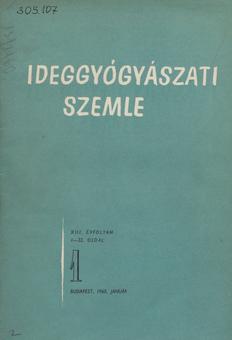The eLitMed.hu medical portal uses computer cookies for convenient operation. Detailed information can be found in the Cookie-policy.
Clinical Neuroscience - 1960;13(01)
Content
[Studies in paroxysmal niyoplegia]
[Authors describe a sister pair with hypokalemic paroxysmal paralysis. In a 22-year-old male patient, a spontaneous paralytic attack of paralysis was observed on the first day with potassium movement towards the musculature and on the second day towards the extracellular space. During the paralysis, muscle biopsy K levels increased by 8%. EEG showed only a slight slowing during the seizure even with a serum K content of 1.9 maequ. During the paralysis, muscle mechanical excitability was increased, as detected by EMG. Aclosterone excretion was increased during the seizure. Meteorological factors may have played a role in triggering the seizure. Authors report ECG and circulatory studies in two patients.Neither patient had persistent muscle weakness. However, EMG findings in both cases showed myogenic lesions and muscle biopsy showed vacuolar lesions and atrophy of muscle fibres. Authors review the literature on potassium challenge, aldosterone secretion, EEG, EMG, ECG and circulatory studies of paroxysmal paralysis.]
[Electroencephalographic studies in psychosis during Antaetliyl treatment]
[An An. psychosis in a premorbid schizothymic sensitive psychopathic alcoholic patient was described. EEGs recorded during psychosis showed lesions consistent with those observed in symptomatic psychosis. In addition to toxic factors, vegetative symptoms accompanying the specific affective state played a role in the onset of psychosis, and the premorbid personality gave the psychosis its presentation. The specific ego disturbances observed in the first phase of psychosis seem likely to be related to the premorbid psychopathic personality on the one hand and to the nodal parietal lesions, which can be followed by electroencephalographic abnormalities on the other.]
[The effect of changes in skin temperature in the external environment on the skin temperature of schizophrenics]
[Authors investigated the skin temperature of young schizophrenics with different behavioural (calm, contactable, inhibited, disturbed, agitated, heboid) forehead, two cheek and chin skin temperatures between 20.0-26.0 C°, with temperature ranges of 0.5, 1.0, l.5°, and l.5°, respectively, while keeping different factors affecting skin temperature constant. The greatest variation in skin temperature values was observed at external temperatures of 21.5° to 22.5°. The variability of values is smaller at lower and higher temperatures. In all external temperature ranges, the values for the right side of the face were the most variable (all patients were right-handed). Curves showing the distribution of skin temperature in relaxed, orderly patients are more regular, with less variation in skin temperature values than those for the whole patient. The authors conclude from their results that, under the given conditions, the variation in skin temperature values indicates different functional states of the nervous system in patients of different behavioural types and that the influence of the nervous system on peripheral vasomotor function is most pronounced at 21.5-22.5 C°. It is therefore recommended that such studies be carried out at the aforementioned external temperature, on the side corresponding to the dominant hemisphere. ]
[A "specifically human structure" based on the functional organisation]
[In recent years, Nyirő's structural concept of psychic organizations has become known from several lectures and publications. There have also been several publications on the usefulness of structural organisationalism in psychological and psychopathological approaches. So far, experience has shown that in the explanation and analysis of psychological phenomena and pathologies, the decomposition of the psychic functio into three major organisational structures, the concept of cognitive, relational and adaptive organisatio, has been useful and can be applied in practice. On the other hand, the structuralist approach is necessarily dynamic, it can change and evolve - and it is evolving, as its creator's recent contributions demonstrate. These two properties: practical usability and potential for development, justify its being called a working hypothesis for the approach, subtle analysis and perhaps even 'understanding' of psychic phenomena.]
1.
Clinical Neuroscience
[Headache registry in Szeged: Experiences regarding to migraine patients]2.
Clinical Neuroscience
[The new target population of stroke awareness campaign: Kindergarten students ]3.
Clinical Neuroscience
Is there any difference in mortality rates of atrial fibrillation detected before or after ischemic stroke?4.
Clinical Neuroscience
Factors influencing the level of stigma in Parkinson’s disease in western Turkey5.
Clinical Neuroscience
[The effects of demographic and clinical factors on the severity of poststroke aphasia]1.
2.
Clinical Oncology
[Pancreatic cancer: ESMO Clinical Practice Guideline for diagnosis, treatment and follow-up]3.
Clinical Oncology
[Pharmacovigilance landscape – Lessons from the past and opportunities for future]4.
5.



